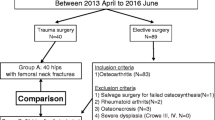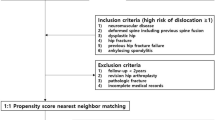Abstract
Purpose
No previous reports have described the benefits and risks associated with the dual mobility cup (DMC) in primary THA via direct anterior approach (DAA). The aim of this study was to compare the safety and rate of early postoperative complication of the DAA with the DMC for THA with those of the DAA with a single standard cup, and to investigate the influence of the learning curve of the use of DMC on intra- and perioperative outcomes.
Methods
We retrospectively investigated 60 hips treated in the single-DAA group and 60 hips treated in the dual-DAA group. A primary/secondary outcome variable was the presence of any intra- or perioperative complication within the first 6 months/the operative time and hip function at 6 months postoperatively. We also analyzed influence of the learning curve of the use of DMC on intra- and perioperative outcomes.
Results
No intraoperative complications were observed in either group. One anterior dislocation and one periprosthetic hip fracture were occurred in the single-DAA group. The surgical times in the single-DAA and dual-DAA groups were 112.0 ± 20.9 and 121.0 ± 26.9 min (p < 0.001). There was no significant difference in the 6-month postoperative hip function scores between the two groups. There was no influence of the learning curve of the use of DMC on intra- and perioperative outcomes.
Conclusion
We have demonstrated the short-term safety and lack of inferiority of using the DMC in the DAA compared with the standard single mobility cup.

Similar content being viewed by others
References
Bozic KJ, Kurtz SM, Lau E, Ong K, Vail TP, Berry DJ (2009) The epidemiology of revision total hip arthroplasty in the United States. J Bone Joint Surg Am 91(1):128–133
Judet J, Judet H (1985) Voie d’abord antérieure dans l’arthroplastie totale de la hanche. Presse Méd 14:1031–1033
Restrepo C, Parvizi J, Pour AE, Hozack WJ (2010) Prospective randomized study of two surgical approaches for total hip arthroplasty. J Arthroplasty 25:671–679
De Geest T, Fennema P, Lenaerts G, De Loore G (2015) Adverse effects associated with the direct anterior approach for total hip arthroplasty: a Bayesian meta-analysis. Arch Orthop Trauma Surg 135(8):1183–1192
Masonis JL, Bourne RB (2002) Surgical approach, abductor function, and total hip arthroplasty dislocation. Clin Orthop Relat Res 405:46–53
Tsukada S, Wakui M (2015) Lower dislocation rate following total hip arthroplasty via direct anterior approach than via posterior approach: five-year-average follow-up results. Open Orthop J 9:157–162
Petis S, Howard JL, Lanting BL, Vasarhelyi EM (2015) Surgical approach in primary total hip arthroplasty: anatomy, technique and clinical outcomes. Can J Surg 58(2):128–139
Rathod PA, Bhalla S, Deshmukh AJ, Rodriguez JA (2014) Does fluoroscopy with anterior hip arthoplasty decrease acetabular cup variability compared with a nonguided posterior approach? Clin Orthop Relat Res 472(6):1877–1885
Bartz RL, Nobel PC, Kadakia NR, Tullos HS (2000) The effect of femoral component head size on posterior dislocation of the artificial hip joint. J Bone Joint Surg Am 82-A:1300–1307
Howie DW, Holubowycz OT, Middleton R, Large Articulation Study Group (2012) Large femoral heads decrease the incidence of dislocation after total hip arthroplasty: a randomized controlled trial. J Bone Joint Surg Am 94-A:1095–1102
Garbuz DS, Masri BA, Duncan CP, Greidanus NV, Bohm ER, Petrak MJ, Della Valle CJ, Gross AE (2012) The Frank Stinchfield Award: dislocation in revision THA: do large heads (36 and 40 mm) result in reduced dislocation rates in a randomized clinical trial? Clin Orthop Relat Res 470:351–356
Blumenfeld TJ, McKellop HA, Schmalzried TP, Billi F (2011) Fracture of a cross-linked polyethylene liner: a multifactorial issue. J Arthroplasty 26:666.e5–668.e5
Duffy GP, Wannomae KK, Rowell SL, Muratoglu OK (2009) Fracture of a cross-linked polyethylene liner due to impingement. J Arthroplasty 24:158.e15–159.e15
Moore KD, Beck PR, Petersen DW, Cuckler JM, Lemons JE, Eberhardt AW (2008) Early failure of a cross-linked polyethylene acetabular liner. A case report. J Bone Joint Surg Am 90-A:2499–2504
Toni A, Baleani M, Bordini B, Stea S, Pilla F, Sudanese A (2012) “Trunionitis”: a cause for concern? Semin Arthroplasty 23:248–250
Cooper HJ, Della Valle CJ, Berger RA, Tetreault M, Paprosky WG, Sporer SM, Jacobs JJ (2012) Corrosion at the head–neck taper as a cause for adverse local tissue reactions after total hip arthroplasty. J Bone Joint Surg Am 94-A:1655–1661
Dyrkacz RM, Brandt JM, Ojo OA, Turgeon TR, Wyss UP (2013) The influence of head size on corrosion and fretting behaviour at the head–neck interface of artificial hip joints. J Arthroplasty 28:1036–1040
Bouchet R, Mercier N, Saragaglia D (2011) Posterior approach and dislocation rate: a 213 total hip replacements case-control study comparing the dual mobility cup with a conventional 28-mm metal head/polyethylene prosthesis. Orthop Traumatol Surg Res 97:2–7
Heffernan C, Banerjee S, Nevelos J, Macintyre J, Issa K, Markel DC, Mont MA (2014) Does dual-mobility cup geometry affect posterior horizontal dislocation distance. Clin Orthop Relat Res 472:1535–1544
Stroh A, Naziri Q, Johnson AJ, Mont MA (2012) Dual-mobility bearings: a review of the literature. Expert Rev Med Devices 9:23–31
Farizon F, de Lavison R, Azoulai JJ, Bousquet G (1998) Results with a cementless alumina-coated cup with dual mobility. A twelve-year follow-up study. Int Orthop 22:219–224
Baba T, Shitoto K, Kaneko K (2013) Bipolar hemiarthroplasty for femoral neck fracture using the direct anterior approach. World J Orthop 4(2):85–89
Rodriguez JA, Rathod PA (2012) Large diameter heads: is bigger always better? J Bone Joint Surg Br 94(11 Suppl A):52–54
Nunley RM, Wilson JM, Gilula L, Clohisy JC, Barrack RL, Maloney WJ (2010) Iliopsoas bursa injections can be beneficial for pain after total hip arthroplasty. Clin Orthop Relat Res 468(2):519–526
Cyteval C, Sarrabere MP, Cottin A, Assi C, Morcos L, Maury P, Taourel P (2003) Iliopsoas impingement on the acetabular component: radiologic and computed tomography findings of a rare hip prosthesis complication in eight cases. J Comput Assist Tomogr 27:183–188
Jasani V, Richards P, Wynn-Jones C (2002) Pain related to the psoas muscle after total hip replacement. J Bone Joint Surg Br 84:991–993
Nasser AB, Beaulé PE, O’Neill M, Kim PR, Fazekas A (2010) Incidence of groin pain after metal-on-metal hip resurfacing. Clin Orthop Relat Res 468(2):392–399
Bartelt RB, Yuan BJ, Trousdale RT, Sierra RJ (2010) The prevalence of groin pain after metal-on-metal total hip arthroplasty and total hip resurfacing. Clin Orthop Relat Res 468(9):2346–2356
Browne JA, Polga DJ, Sierra RJ, Trousdale RT, Cabanela ME (2011) Failure of larger diameter metal-on-metal total hip arthroplasty resulting from anterior iliopsoas impingement. J Arthroplasty 26:978.e5
Hamadouche M, Arnould H, Bouxin B (2012) Is a cementless dual mobility socket in primary THA a reasonable option? Clin Orthop Relat Res 470(11):3048–3053
Seng BE, Berend KR, Ajluni AF, Lombardi AV (2009) Anterior-supine minimally invasive total hip arthroplasty: defining the learning curve. Orthop Clin North Am 40(3):343–350
Woolson ST, Pouliot MA, Huddleston JI (2009) Primary total hip arthroplasty using an anterior approach and a fracture table: short-term results from a community hospital. J Arthroplasty 24(7):999–1005
Jolles BM, Zangger P, Leyvraz PF (2002) Factors predisposing to dislocation after primary total hip arthroplasty: a multivariate analysis. J Arthroplasty 17(3):282–288
Berry DJ, von Knoch M, Schleck CD, Harmsen WS (2004) The cumulative long-term risk of dislocation after primary Charnley total hip arthroplasty. J Bone Joint Surg Am 86(1):9–14
Newington DP, Bannister GC, Fordyce M (1990) Primary total hip replacement in patients over 80 years of age. J Bone Joint Surg Br 72(3):450–452
Hedlundh U, Karlsson M, Ringsberg K, Besjakov J, Fredin H (1999) Muscular and neurologic function in patients with recurrent dislocation after total hip arthroplasty: a matched controlled study of 65 patients using dual-energy X-ray absorptiometry and postural stability tests. J Arthroplasty 14(3):319–325
Lübbeke A, Suvà D, Perneger T, Hoffmeyer P (2009) Influence of preoperative patient education on the risk of dislocation after primary total hip arthroplasty. Arthritis Rheum 61(4):552–558
Authors’ contribution
YH and DA designed the study. YH, MM, HO, YO, and TB obtained and analyzed the data. YH wrote the initial draft. KK and TY ensured the accuracy of the data and analysis.
Author information
Authors and Affiliations
Corresponding author
Ethics declarations
Conflict of interest
The authors declare that they have no conflict of interest.
Ethical approval
All procedures performed in studies involving human participants were in accordance with the ethical standards of the institutional and/or national research committee and with the 1964 Helsinki Declaration and its later amendments or comparable ethical standards. The study was approved by the medical research ethics committee at our university.
Informed consent
Informed consent was obtained from all individual patients in this study.
Rights and permissions
About this article
Cite this article
Homma, Y., Baba, T., Kobayashi, H. et al. Benefit and risk in short term after total hip arthroplasty by direct anterior approach combined with dual mobility cup. Eur J Orthop Surg Traumatol 26, 619–624 (2016). https://doi.org/10.1007/s00590-016-1808-5
Received:
Accepted:
Published:
Issue Date:
DOI: https://doi.org/10.1007/s00590-016-1808-5




